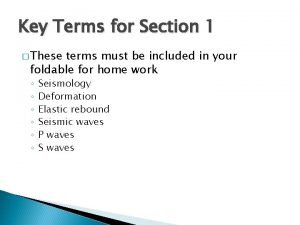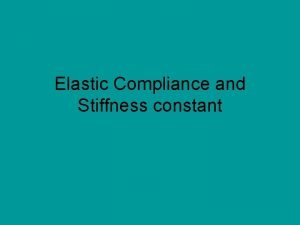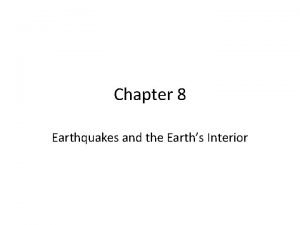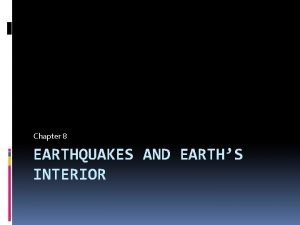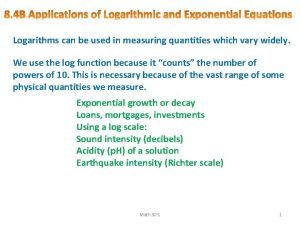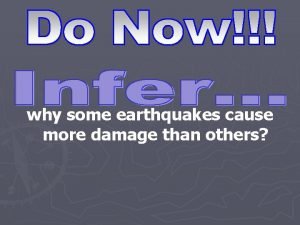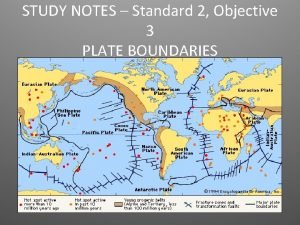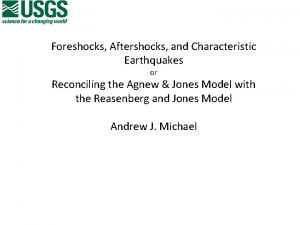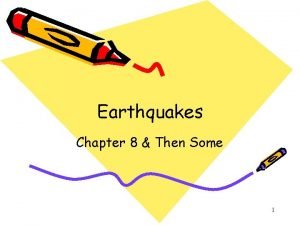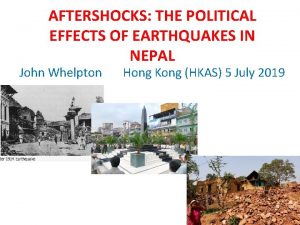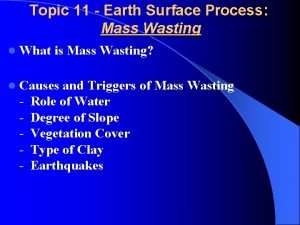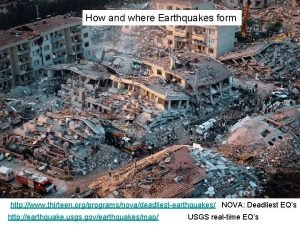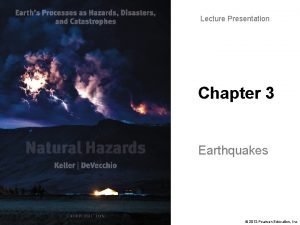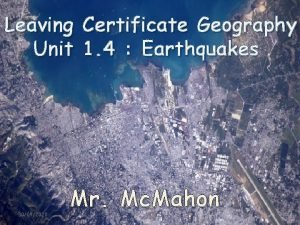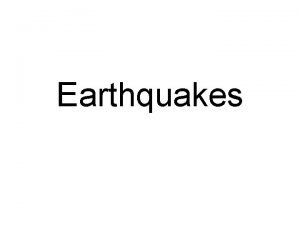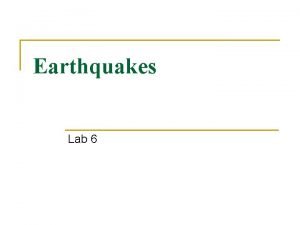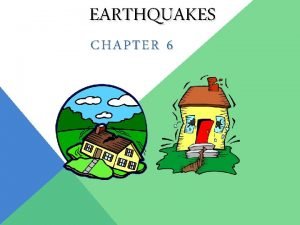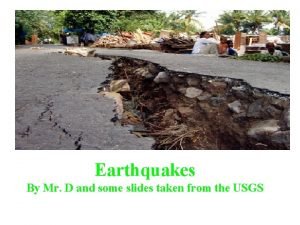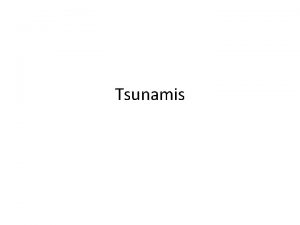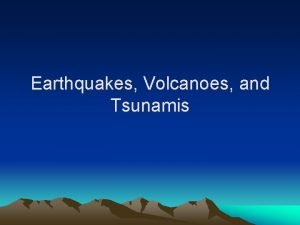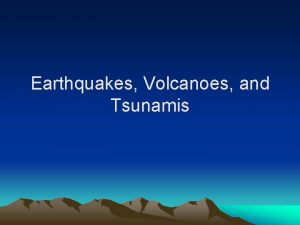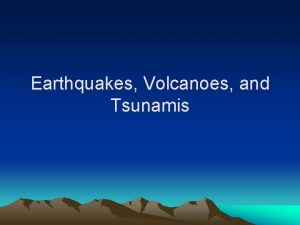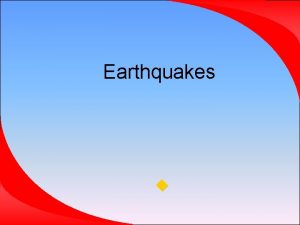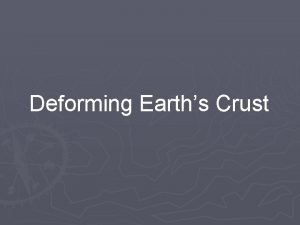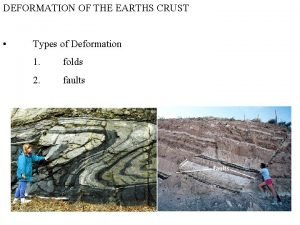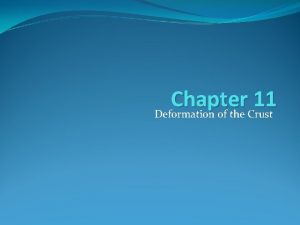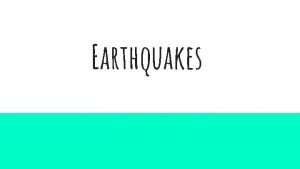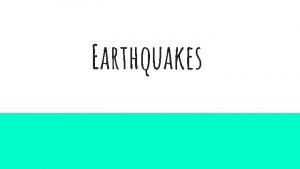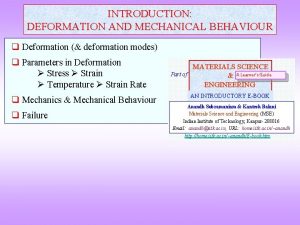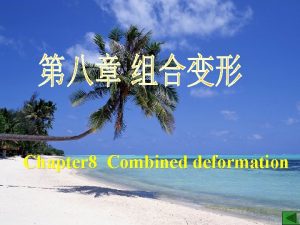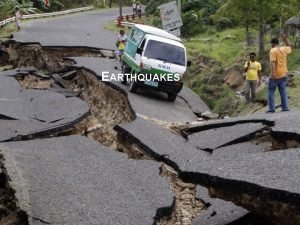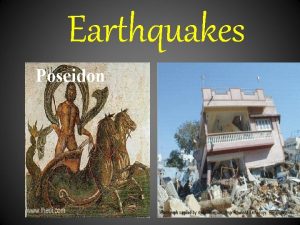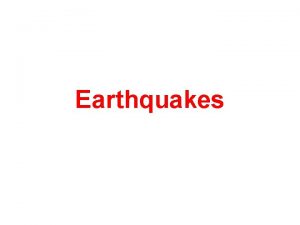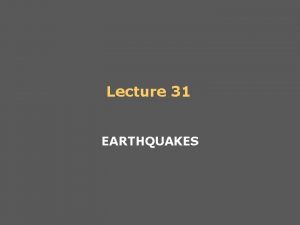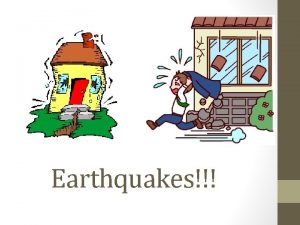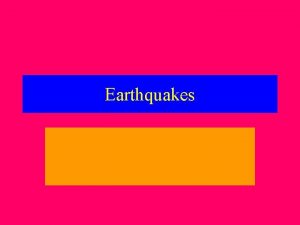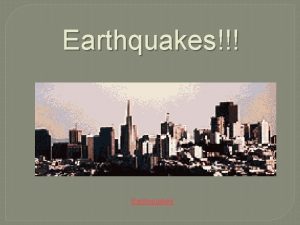Earthquakes and Tsunamis Crust Deformation Deformation is the



























- Slides: 27

Earthquakes and Tsunamis

Crust Deformation • Deformation is the bending, tilting, and breaking of the earth’s crust. • Plate tectonics is the major cause of crustal deformation. • Stress is a force that causes pressure in the rocks of the crust. • Strain – a change in the shape or volume of rocks that results from the stress of being squeezed, twisted, or pulled apart.

Stress § Compression – reduces the volume of rocks. This occurs when they are squeezed together. § Tension – pulls rocks apart and makes them thinner. § Shearing – pushes rocks in opposite horizontal directions. Sheared rocks bend, twist, or break apart as they slide past each other.

Folds § Folding – this occurs when rock responds to stress by becoming permanently deformed without breaking. § Folds appear as a wavelike structures in rock layers.

Faults § There are two types of breaks in rocks: § Fracture: when there is no movement in the rocks along either side of a break. § Fault: when the rocks move after breaking.

Earthquakes • Vibrations of the earth’s crust are called earthquakes. • Earthquakes usually occur when rocks under stress suddenly shift along a fault. • Normally the rocks along both sides of a fault are pressed together tightly. • Friction prevents the rocks from moving past each other – the fault is “locked. ” • When the stress becomes too great, the rocks suddenly grind past each other. • This slippage causes the trembling and vibrations of an earthquake.

Elastic Rebound Theory • Elastic Rebound Theory states that rocks on each side of a fault are moving slowly, and when the rocks are stressed to a certain point, they will fracture, separate at their weakest point, and spring back to their original shape, or rebound. • Aftershocks are the smaller tremors that can be felt after an earthquake. • Focus – the area along a fault where the slippage first occurs • Epicenter – the point on the earth’s surface directly above the focus


Seismic Waves § When an earthquake occurs, seismic waves radiate outward in all directions from the focus. § Earthquakes that cause the most damage usually have a shallow focus. This means that they are not very deep under the ground – within 43. 5 miles from the earth’s surface.


Earthquake Zones • The earth has three major earthquake zones. – Pacific Ring of Fire – Mid-ocean Ridge – Eurasian-Melanesian Mountain Belt • Most earthquakes occur along or near the edges of the earth’s lithospheric plates. • It is at these moving plate boundaries that stress is greatest and rocks experience the greatest amount of strain.

Pacific Ring of Fire

Mid-ocean Ridge

Eurasian-Melanesian Mountain Belt

Remember this…?

What do you notice?

Compare it to this…!

Recording Earthquakes • Seismograph – this is the instrument that can detect and record seismic waves. • Every earthquake produces three major types of seismic waves that each travel at different speeds and causes different movements in the earth’s crust.

Waves • P waves – primary waves – they move the fastest and are the first to be recorded. Travel through solids and liquids • S waves – secondary waves – they are the second to be recorded. Only travel through solid material. • L waves – slowest moving and last to be recorded. These cause the surface to rise and fall and create the most damage.

Richter Scale § This is used to express the magnitude of an earthquake. § Magnitude is a measure of the energy released by an earthquake. § Each increase of one whole number of magnitude represents a release of 31. 7 times more energy than that of an earthquake measuring one whole number lower. § An 8 would be 31. 7 x 31. 7 (~1000) times more than a 6


Tsunamis • A major earthquake with an epicenter on the ocean floor sometimes causes a giant ocean wave called a tsunami. • These are caused by faulting and underwater landslides. • Faulting may cause a sudden drop or rise in the ocean floor. • The water above a landslide is thrown into an up-and -down motion, thereby creating a series of tsunamis.


Possible Damage from Earthquakes • Death/injury • Collapsed buildings • Landslides • Fires • Explosions • Flood • Flying glass • Falling objects


Earthquake Safety §Before an earthquake, be prepared! § Canned food, bottled water, flashlights, batteries, portable radio, have a plan §During an earthquake, stay calm! § Inside – protect yourself from falling debris, stay away from windows, doors, and things that can fall over § Do not run outside. § In a car – stay in the car until the tremors stop and stop in a place away from tall buildings, tunnels, power lines, and bridges. §After an earthquake, be cautious! § Check for fire hazards, wear closed-toe shoes, avoid power lines.

Your Task: • Create a creative, eye-catching, colorful, informative, comprehensive brochure and include the following: – How earthquakes happen • What causes them? • Explain how the fault lines and plate boundaries play a role in earthquakes. • Include a section on plate tectonics – How tsunamis happen • What causes them? – Possible damage that can result from an earthquake – Earthquake safety • What to do before an earthquake. • What to do during an earthquake. • What to do after an earthquake.
 Elastic rebound
Elastic rebound Elastic strain and plastic strain
Elastic strain and plastic strain Chapter 8 section 1 what are earthquakes answer key
Chapter 8 section 1 what are earthquakes answer key Chapter 8 earthquakes and volcanoes
Chapter 8 earthquakes and volcanoes Chapter 8 earthquakes and earth's interior
Chapter 8 earthquakes and earth's interior Chapter 8 earthquakes and earth's interior
Chapter 8 earthquakes and earth's interior What is the crust
What is the crust In what section of earth do earthquakes happen
In what section of earth do earthquakes happen Btn earthquakes
Btn earthquakes Define natural disaster
Define natural disaster Http://earthquake.usgs.gov/earthquakes/map/
Http://earthquake.usgs.gov/earthquakes/map/ A large crack in the earth formed by a river or earthquakes
A large crack in the earth formed by a river or earthquakes Chapter 19 earthquakes
Chapter 19 earthquakes The ______ of a seismograph moves.
The ______ of a seismograph moves. Frequent earthquakes in an area may indicate
Frequent earthquakes in an area may indicate Earthquakes
Earthquakes Chapter 8 quiz 1
Chapter 8 quiz 1 Earthquakes
Earthquakes Mass wasting processes
Mass wasting processes Why do earthquakes occur
Why do earthquakes occur Epicenter of earthquake
Epicenter of earthquake 5 effects of earthquakes
5 effects of earthquakes How high does the richter scale go
How high does the richter scale go The point on the ground directly above the focus
The point on the ground directly above the focus Diastrophic meaning
Diastrophic meaning Causes of earthquake
Causes of earthquake Whats the main cause of most earthquakes
Whats the main cause of most earthquakes Normal fault definition
Normal fault definition
